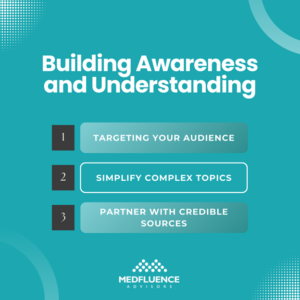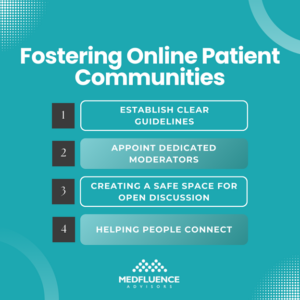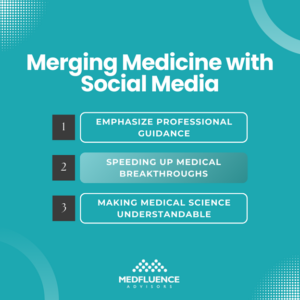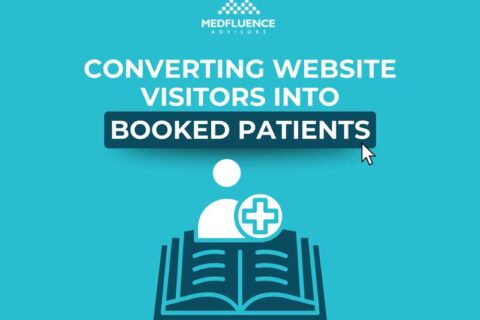Facebook’s Impact On Emerging Medicine: A Guide To Best Practices
click here to receive a free
Digital Marketing Playbook
As scientific discoveries continue to unfold, the realm of medical possibilities has reached new heights. These innovations have the potential to reshape the way we manage diseases, bringing about remarkable transformations in healthcare. However, a crucial challenge exists: the gap between rapid advancements in the lab and public understanding of these complex therapies.

This is where Facebook, with its vast reach and capacity for connection, enters the picture. When used responsibly and strategically, this familiar social media platform can be a powerful tool. To harness Facebook effectively for emerging medicine, it’s vital to understand best practices and ethical considerations. This guide is designed to assist medical professionals, researchers, patient advocates, and anyone with an interest in this field in maximizing their use of Facebook. Below, we break down the 10 strategies for effective practices in optimizing your Facebook presence between three main channels: Building Awareness and Understanding, Fostering Online Patient Communities, and Merging Medicine with Social Media.
Building Awareness And Understanding
The most sophisticated medical innovations are only as impactful as the public’s understanding of them. Facebook offers a unique opportunity to bridge this knowledge gap and build widespread awareness of emerging medical treatments. Here’s how:
1. Targeting The Right Audience
- Interests: Go beyond general health by targeting those interested in science, medical research, or specific conditions that emerging therapies address.
- Specificity is key. Get granular by searching for interest categories like “Regenerative Medicine,” “Clinical Trials,” “Precision Medicine,” or “Nanomedicine,” etc.
- Target audiences interested in technology, futurism, scientific publications (like Scientific American, Nature, etc.), or specific medical journals (e.g., JAMA, The Lancet).
- Research relevant patient support groups on Facebook and target users interested in related pages and groups.
- Demographics: Tailor your approach based on age groups or locations potentially relevant to specific therapies. Consider age as a factor. Focus on age ranges most likely to be affected by the conditions your discussed therapies address. Consider if early adopters might skew younger. Also, try location targeting. Prioritize areas near major research hospitals or universities known for cutting-edge medical research. Target locales hosting relevant medical conferences or biotech hubs.
- Behaviors: Seek users who engage with medical content, biotechnology news, or research institutions online.
- You might have heard that ‘content is king,’ but relevance is its crown. Pinpoint users who actively like, comment, and share posts from medical professionals, research institutions, and healthcare-focused news outlets. Focus on those engaging with reputable, high-quality content that demonstrates a strong interest in understanding the complexities of emerging treatments. This indicates a higher likelihood of receptivity to your own educational content.
- To target individuals with a strong interest in emerging medicine, focus on their online activity. Seek out users who visit the websites of reputable medical journals, clinical trial databases like gov, or innovative biotechnology companies known for their involvement in cutting-edge research. By identifying people who actively engage with these resources, you’ll hone in on an audience receptive to your content.
- Similarly, consider targeting individuals who express interest in or register for well-respected medical conferences or attend healthcare-related webinars. Zero in on events focused on topics aligning with your article’s area of emerging medicine, ensuring you’re reaching those with a genuine thirst for the latest medical advancements.
2. Demystifying Complex Topics
- Infographics: Go beyond basic visuals. Use clear labeling, numbered steps, and visual metaphors to make advanced concepts easier to understand. Consider collaborating with a medical illustrator to ensure both accuracy and visual appeal. You can also check out resources like Canva or Visme for medical infographic templates.
- Short, Animated Videos: Aim for videos under 3 minutes for maximum engagement. Focus on a single concept per video. Use motion and narration to guide viewers through complex processes in a memorable way. Include closed captions for accessibility.
- Layman’s Explanations: Think beyond jargon removal. Use analogies to everyday objects or experiences to ground abstract medical concepts. Invite a diverse range of voices (doctors, researchers, patients) to offer different perspectives and make the content relatable.
3. Partnering With Credible Sources
- Hospitals and Research Centers: Go beyond sharing their content. Invite doctors for Q&A sessions on your page. Feature interviews with researchers explaining their groundbreaking work. Explore joint webinars or public outreach events. Cross-promote their content and co-create awareness campaigns.
- Patient Advocacy Groups: Work with organizations dedicated to specific conditions that emerging therapies could address. Their expertise and existing audience can enhance your reach. Leverage their established trust with patients. Host a patient panel discussion on their experiences with emerging therapies. Collaborate on explainers that address the specific concerns of their community. Be sure to center the patient’s voice and experience.

click here to receive a free
Digital Marketing Playbook
Fostering Online Patient Communities

click here to receive a free
Digital Marketing Playbook
New medical treatments bring complex diagnoses, unfamiliar protocols, and uncertainty. Facebook offers dedicated online communities where patients, families, and caregivers can connect, share experiences, and find support. Here’s how responsible establishment and maintenance of these communities help in creating safe and supportive environments:
1. Establish Clear Guidelines
- Clear community guidelines are essential. These should set explicit expectations for respect, empathy, and the use of reliable sources (such as peer-reviewed research or information from reputable medical institutions). Prohibit self-promotion, harmful claims, and any form of discrimination.
- We want this to be a place where everyone feels comfortable. It’s super important to have clear rules about staying respectful and making sure people get their information from reliable places – you know, studies in medical journals, big hospitals, that kind of thing.
2. Appoint Dedicated Moderators
- Having dedicated moderators, ideally with a background in healthcare or patient advocacy, is crucial. Their role is to enforce the guidelines, address disruptive behavior, and guide the community toward constructive conversations.
- Moderators will hold the community accountable for staying aligned with the organization’s rules of engagement and keep said rules established and protected. They will follow a predetermined escalation path for moderating.
3. Creating A Safe Space For Open Discussion
- When fostering online patient communities, privacy and data protection must be top priorities. Clearly outline how personal health information will be handled; emphasize anonymity, including the avoidance of real names whenever the subject matter is sensitive, and explore options for secure messaging or private subgroups within the community.
- It’s vital to continuously remind members that peer support, while incredibly valuable, should never replace professional medical advice. Encourage them to consult qualified doctors for diagnoses, treatment decisions, and any concerns about side effects.
- Should you wish to explore the use of community data for research purposes, transparency is paramount. Always obtain explicit informed consent, partner with an ethical review board, and ensure the strictest standards of patient privacy remain in place.
4. Helping People Connect
- Healthcare providers can use social platforms to deliver educational content tailored to those undergoing emerging treatments. This could include videos explaining how therapies work, downloadable guides on navigating the treatment process. Accessibility is important – providing information in multiple formats benefits broader audiences.
- Patient communities online become invaluable resources, especially for those navigating novel treatments. In partnership with medical institutions, they can curate reliable information on managing side effects, offering everything from vetted medical advice to practical tips shared from lived experiences. This creates reassurance that accurate information is readily available while also building a vital support network.

click here to receive a free
Digital Marketing Playbook
Merging Medicine with Social Media
In the rapidly evolving world of emerging medicine, collaboration isn’t just a buzzword – it’s the key to success. The most impactful breakthroughs happen when researchers, patients, healthcare providers, and social media platforms unite. Each brings a unique strength to the table, and the results speak for themselves. For instance, consider the recent clinical trial that sped up recruitment dramatically thanks to strategic social media outreach. These partnerships drive progress and improve patient outcomes.
Beyond that, proactive collaboration can head off problems before they start. Open communication between healthcare experts, social media platforms, and patient communities allows for a rapid response to misinformation. This kind of vigilance protects the integrity of emerging treatments and builds essential public trust in this cutting-edge field.
Here’s how these partnerships result in positive outcomes:
1. Making Medical Science Understandable
- Researchers often struggle to translate complex findings into language the public can understand. Collaborating with skilled science communicators and leveraging the visual tools of social platforms allows for the creation of content that’s both engaging and informative. Infographics, short explainers videos, or even researcher interviews can break down emerging therapies into digestible concepts.
- Pairing scientific explanations with patient testimonials (always with explicit consent!) makes the abstract come alive. Sharing stories of how emerging therapies have impacted real lives puts a human face on medical progress. This resonates emotionally with the public, building greater trust and acceptance of innovative treatments.
- Emerging medicine can seem scary to some. Emphasize how these collaborations aim to replace fear with knowledge, empowering the public to make informed decisions about their health.
- Highlight the fact that medical institutions are actively involved in content creation or sharing on social media. This lends credibility and underscores the commitment to reliable information.
2. Speeding Up Medical Breakthroughs
- Social media bridges the gap between researchers and the people they seek to help. Patient communities offer invaluable insights into real-world disease experiences, guiding researchers toward treatments that address true unmet needs. This direct connection ensures research is focused on what matters most to patients.
- Finding the right participants for clinical trials can be time-consuming and costly. Social platforms, with their targeted advertising and vast user base, can make recruitment far more efficient. Researchers can connect with potential participants who fit specific criteria, potentially speeding up trials and getting effective treatments to patients sooner.
- Patient advocacy groups are powerful voices within their communities. Collaborating with them amplifies messages about clinical trials and research initiatives. This partnership not only raises awareness but instills trust, encouraging more patients to consider taking part in cutting-edge research.
3. Emphasize Professional Guidance
- Misinformation about emerging treatments can spread rapidly. Maintaining regular channels of communication between social media platforms, researchers, and patient communities makes it much easier to spot misleading claims early. This allows for a swift and coordinated response to mitigate the spread of potentially harmful falsehoods.
- Discussions about data privacy, ethical use of patient information, and how platforms handle sensitive medical content shouldn’t happen behind closed doors. Transparent communication about these issues builds public confidence. It signals that Facebook takes its role in this space seriously and prioritizes the safe and responsible use of its platform.
- Be proactive. Frame open communication as a preventative measure. It’s far better to address potential problems through dialogue than to be caught scrambling after a misinformation crisis has erupted.
Position all stakeholders (platforms, experts, and the public) as partners in maintaining a trustworthy information environment. This combats the “us vs them” mentality that can hinder progress.

click here to receive a free
Digital Marketing Playbook
To Summarize: The Future Of Facebook And Emerging Medicine
When it comes to relying on Facebook for medical information, the ultimate goal is to make informed decisions about our health by tapping into reliable sources, such as researchers, medical institutions, and companies that consistently share accurate and up-to-date information. It’s like having a trusted circle of experts who have our backs when it comes to our well-being. That’s the key to making the most of Facebook as a source of helpful medical knowledge.
Envision Facebook as a hub, a vibrant platform where we can connect not just with friends and family, but also with like-minded individuals who share our passion for emerging medicine. By embracing a collaborative, evidence-based approach, we can transform this platform into a responsible and invaluable resource for information.
United, we can harness the collective wisdom of the community, nurturing a fertile ground for innovation and scientific discovery. This journey is not merely about connecting with others; it’s about coming together as a global village, united in our mission to advance medical progress and make a tangible difference in the lives of people everywhere. The time is now. Let’s seize this opportunity and shape the future of healthcare, together.



